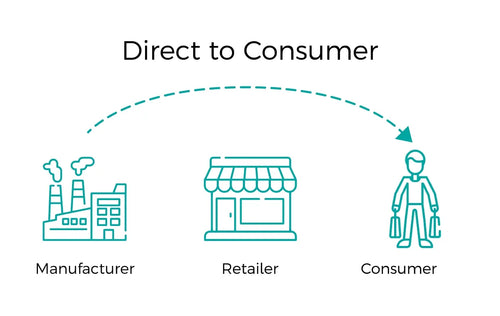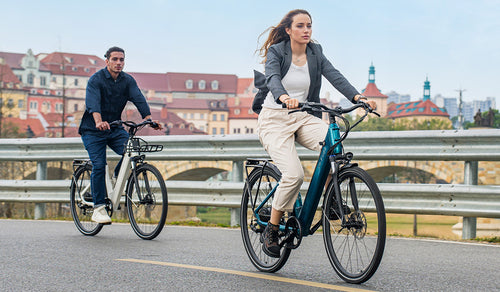We're here to fill you in with all the details of electric bike essentials to give you the best start. Let's get into it!
How Do Electric Bikes Work?
Let's start with the basics. An electric bike is designed to assist your pedaling with a battery-powered motor. The motor amplifies your pedaling efforts, making typically challenging hill climbs and headwinds a thing of the past. This assistance also means arriving at your destination without getting hot and sweaty like on a regular bike. On the other hand, you can use an electric bike for fitness, too. By riding in a lower assistance level, you must pedal harder to maintain the same speeds, boosting cardiovascular health and building muscle.
Comparing An Electric Bike To A Traditional Bike
There are some characteristics electric bikes share with their traditional counterparts. For example, they share similar components, such as drivetrains, gears, and handlebars. Their frame designs are similar, too, with comparative geometry figures, depending on which type of bike you ride. The great thing about these common elements is that going from a regular bike to an electric bike is easy.
When you pedal an electric bike for the first time, you should immediately feel at home on it. Pedaling and changing gears is the same as when riding a regular bike. You'll notice the brakes are more powerful, though, so be sure to get a feel for them before heading off on a big adventure.
The main thing you'll notice when comparing an electric bike to a regular one is its weight. The motor and battery system increase the weight, but this is fine when riding, as the motor counteracts its own weight. You may find lifting an electric bike challenging if you have to carry it upstairs or load it onto a bike rack. But you can buy lightweight and foldable electric bikes that are more manageable.
Electric Bike Assistance Levels
Most electric bikes have three of four assistance levels, depending on their controllers. Which assistance level you select depends on how energetic you're feeling and your route. If you were approaching a steep hill, you would typically select a higher assistance level and a lower gear to make it easy. However, higher assistance levels use up more battery power as the motor works harder.
Riding in lower assistance modes, such as "Eco Mode," gives you more range as the motor doesn't demand too much from the battery. You have to pedal harder in lower assistance modes, but this is great for fitness and ensuring you complete longer rides before charging your battery.
The motor will assist your pedaling up to its maximum top speed, determined by its class (see below). The motor disengages at the top speed, but you can still ride beyond it if you ride downhill or pedaling hard.
Electric Bike Classes
Electric bike rules and regulations vary all over the world. Therefore, it's worth doing your homework to ensure you stay on the right side of the law.
Generally, electric bikes come in one of three classes, and your local laws may stipulate that you can only ride a specific class of electric bike. Here's a breakdown of the three classes:
Class 1: These can be known as "pedelec" ebikes. These electric bikes assist your pedaling only up to 20 mph.
Class 2: These electric bikes also assist your pedaling up to 20 mph. However, they also have a throttle, so you can ride it like a scooter without pedaling.
Class 3: These are similar to Class 1 electric bikes but have an assisted top speed of 28 mph.
Those of you new to electric bikes may want to choose a Class 1 electric bike. These are the most affordable and are accepted by most electric bike laws. You can often ride Class 1 electric bikes on roads and bike paths, but it's best to check your local laws to make sure.
Generally, Class 1 and 2 electric bikes can be ridden in the same places. This is because they have the same limited top speed when the motor is running.
Class 3 electric bikes are much more powerful and can reach higher speeds than Class 1 and 2. The rules for Class 3 electric bikes are often stricter, and you may need insurance to be able to ride one.
We recommend that you check your local electric bike laws and regulations. They change regularly, so being up to date is extremely valuable, especially if your electric bike is your primary mode of transport.
Electric Bike Battery Essentials
One of the biggest challenges for electric bike manufacturers is balancing performance with range. Powerful electric bikes are fast and make riding uphill easy. However, if they are not coupled with the correct battery, the battery will run out of power quickly, reducing your range.
Working out how far an electric bike can go on a single charge is challenging. Several factors influence how far you can ride an electric bike before you need to plug it in. For example, if you ride in a hilly area or are a heavier rider, your range will be shorter as the motor demands more from the battery.
An electric bike with a large-capacity battery will give you more range. The capacity is indicated by how many "Watt-hours (Wh)" it has, which indicates how many hours the battery can endure 1 Watt of power before it's empty.
You also need to be aware of the motor's power in relation to the battery capacity. For example, suppose your electric bike has a 500W motor and a 500Wh battery. In that case, you'll run out of power much quicker than if you had a 250W motor with the same battery.
How Long To Charge An Electric Bike Battery?

Charging an electric bike battery depends on its capacity and the charger. For example, the Fiido X Power's 417.6Wh battery takes about 7 hours to charge, which is quite typical. Therefore, we recommend that you charge your battery overnight so it's ready for your morning ride.
You may want to buy an extra battery if you travel long distances. This way, you can have a charged battery in your backpack ready to extend your electric bike's range.
It's worth noting that you can ride an electric bike with a dead battery. It will feel like a regular bike, just a bit heavier.
Electric Bike Essential Features
There are many types of electric bikes on the market. Which one you choose depends on your needs and wants. Here are a few features you may want to consider when buying an electric bike:
Lights
Most modern electric bikes built for commuting have integrated lights or have them mounted on the front and rear. The best lights are bright LEDs that illuminate the road ahead and alert your presence to other road users in low light conditions.
Cargo Racks
Cargo racks are incredibly useful and are essential if you carry a lot of stuff. Not all electric bikes have the provisions for racks, but if carrying capacity is a priority, you may want to choose an electric cargo bike. A great example of one of these is the Fiido T1 Pro. This has a strong frame and sturdy cargo racks over both wheels. It also has a powerful motor and battery, so you can easily move all that weight.

LCDs
The LCD fitted to an electric bike provides vital information. You can check your battery status, look at what assistance level you're using, and monitor your distance, speed, etc; some even have navigation included.
Before you buy an electric bike, it's a good idea to check if its LCD is easy to read. If you can't see important information when riding through heavy traffic, you'll be extremely frustrated, especially if you're trying to manage the last few bars of battery power.
Connectivity
Some electric bikes have connectivity, so you can unlock more features with a mobile phone app. For example, the app could provide GPS navigation, an alert when it's due for a service, and even your bike's location if it's stolen.
Security
A few electric bikes on the market have built-in security systems. These are great for your peace of mind, as you know your electric bike is reasonably safe. A great example of this is the keycode system on the Fiido X Power. This system renders the bike useless unless you have the code to activate it.
Final Thoughts On Electric Bike Essentials
As you can see, there's nothing to worry about when going from a regular bike to an electric bike. The information we've just provided you with will give you a good start when it comes to riding your first electric bike. Why not check out the Fiido online store to see our fantastic offerings that are suitable for many electric bike riders' needs?













